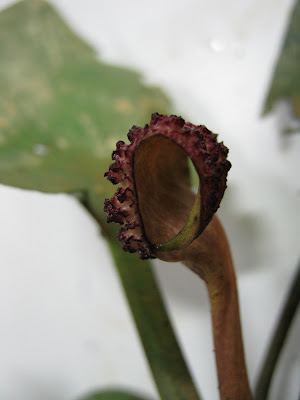- cryptocorynes from Lingga Island were used as test specimens but these cryptocorynes were not from the same location on Lingga island
- the quantity of fertiliser used varies, with some fertiliser having additional dosage added during the test period so the effectiveness might had been affected by this
- no control sample without fertiliser added was present to compare between samples with and without fertiliser added
- the after effects (i.e. after 26th Sep 2010) will not be recorded so the fertiliser's effectiveness over extended period of time would not be captured
- test not carried out on other types / species of cryptocorynes and therefore the results might not be applicable for other species
- test was carried out for my method of cultivation (i.e. emersed with aquasoil in covered tank) and therefore the results may not be applicable to other method of cultivation (i.e. submersed, etc)
- the way the fertiliser was applied was different, some on the top of the substrate and some inserted into the substrate and this difference should have impacts on the effectiveness of the fertiliser applied
- etc
11th July 2010 - Overview
26th Sep 2010 - Overview
The details are as follow:
Pot 1: Organic Humus 8-8-8 (about 1/2 tea spoon added on the top of the substrate twice, once on 11th July 2010 and the other during end July 2010)
11th July 2010 - Pot 1 (Organic Humus)
26th September 2010 - Pot 1 (Organic Humus)
Pot 2: Ferka Rosetta (1 capsule added on 11th July 2010, inserted into substrate)
11th July 2010 - Pot 2 (Ferka Rosetta)
26th September 2010 - Pot 2 (Ferka Rosetta)
Pot 3: Dennerle Cryptocoryne Tabs (1 capsule added on 11th July 2010, inserted into substrate)
11th July 2010 - Pot 3 (Dennerle Cryptocoryne Tabs)
26th September 2010 - Pot 3 (Dennerle Cryptocoryne Tabs)
Pot 4: ijo organic worm casting (added 1 teaspoon heap twice on the top of the substrate, once on 11th July 2010 and the other during end July 2010)
11th July 2010 - Pot 4 (ijo organic worm casting)
26th Sep2010 - Pot 4 (ijo organic worm casting)
So, with some many constraints and limitations listed above, I believed that the results should be considered as inconclusive and if that is the case, why did I ever bothered to make this blog entry?!?!?!?!?!?























































